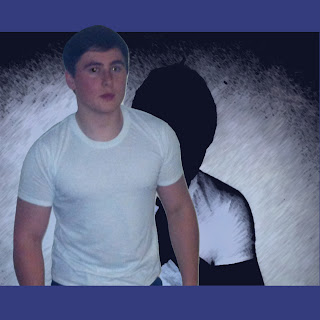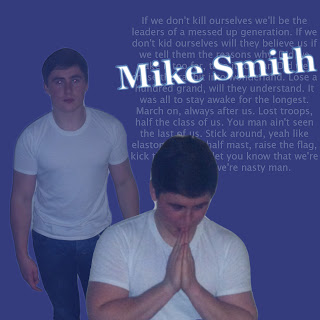After analysing all of our groups second digipaks we decided that we would use my digipak as our final product. We all agreed that it contains most of the conventions of a dance genre digipak and we felt it reflected our artists image the best.
This is our final digipak:
I created this sketched effect by editing a photo of our artist on photoshop. The shadowed effect adds a sense of mystery to the artists which links well with the lyrics of the single 'Stay Awake' which we are creating a music video for, as the lyrics are more dark and deep compared to other dance songs. The font of the writing for the artists name, Mike Smith, and the album name, 'Stay Awkae', is bold and clear and the white colour makes it stand out clearly on the dark background. The colour scheme for my digipak was a dark blue colour as it is quite bright, which represnts the dance genre, but also quite deep which again adds to the mystery.

This is the thank you note I created which is found in most digipaks. It gives our artist, Mike Smith, a chance to thank everyone that has helped him with his album, and this usually excites the reader as they will enjoy be recognised for helping the artist.
I used the reverse colour scheme of the front cover, as I put the deep purple/blue colour around the edges to make it more eye catching, with the black colour in the centre to help make the white font stand out more.

This is just a page with pictures of the artist on to entertain the audience. The image shows the artist, Mike Smith, looking directly in front of him which could give the idea that he is looking at the reader. I again kept to the blue colour scheme and i used the same effect on the background image as I did on the front cover. This image acts as a kind of shadow as it is balck and positioned behind the other picture.
This is quite a simple slide as it will be covered by the actual CD. I continued to use the same blue/purple colour scheme throughout this slide and copied the same font from the front cover to keep my digipak consistent. I also put a light blue glow around the text in order to make it stand out more on the blue/purple background.

This is another picture slide to entertain the audience. I put a fade effect on to these two images of the artist to make them blend well into eachother, yet still stand out on the blue background. To make this slide more interesting I wrote some of the lyrics to one of Mike Smiths biggest hits, Stay Awake, in a faded white font. I then added Mikes Smiths name over the top of it in a bright white colour with a blue glow around it to make it stand out more. Having images of the artist in the digipak is a common convention of dance genre digipaks as the audience want to know as much as they can about the artist and they want to be able to see their image and lifestyle.

This is the back cover that I created on photoshop, the image is a typical convention of dance genre music videos, as it shows a fun and exciting atmosohere in a crowd watching the artist perform. This will excite the audience as they will want to listen to his music if they know this many people already enjoy listening to him. I included the necessary details on the back cover that are typical conventions of digipaks, such as the track list and the artists record labels logo.
This is Carrie's Digipak:
This is Carrie's second Digipak attempt which we were also considering using as our final product, it relates to the dance genre very well with its use of bright colours, bold fonts and close up picture of the artist.
This is Carrie's front cover for Mike Smith's digipak, it is very bright with the fireworks in the background, this relates well to the dance genre as one of its main characteristics is bright vcolours. Also, in the foreground is a close up photo of the artist himself, this would attract the audiences attention as they would be intrigued by the image as it would allow them to see the artists image and ligfestyle as they will be alble to see what he wears. Also, the bold yellow font of the artists name and album title will help to attract the artists attention as it is bright and also connotes ideas of fun which relates to the dance genre.
Carrie's Thank You page is also very bright which again links to the dance genre conventions and our group decided we liked the bright blue border with the bold orange font, as it contrastes well with the black centre background. The last sentence which is in capital letters stands out on this slide and it would excite the readers as this sentence is trying to flatter them and encourage them to continue supporting the artist, Mike Smith.

Our group liked this slide of Carrie's as the red font is very bold on the black background and contrasts well with the white border. Also she edited some of the artists song lyrics in a smaller and faded font to go behind the albums title, this looks very good on the dark backgound. This slide is where the actual album CD will be, so when the CD is in it's case/digipak, this slide will be covered.
This is Carrie's back cover, it uses the same colour scheme as her previous slides, as it has the black background with the blue border and red writing. This slide is also good as it uses the artists record labels logo, our group decided that this was a very important feature to include on the back cover in order to make the digipak look more professional, and we also decided we liked the blue and black colour scheme, this colour scheme is similar to our final digipak.



































